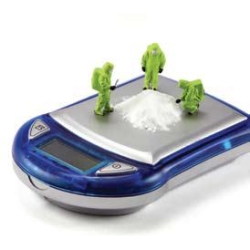 In 2006 the UN issued a global warning for a drug that threatened both the developed and developing world. A drug they said would push health resources to their limits. They called it the “biggest drug crisis worldwide”.
In 2006 the UN issued a global warning for a drug that threatened both the developed and developing world. A drug they said would push health resources to their limits. They called it the “biggest drug crisis worldwide”.
Two years later methamphetamine is virtually absent from the UK and global use is falling. Ashley McKimm investigates if the fear over methamphetamine was just a myth or if the drug remains a threat to UK healthcare.
Each weekend in the clubs of Vauxhall and Greater Manchester dealers are offering free hits of crystal meth alongside their regular supply of pills and stimulants. Their aim is to get their clients hooked on one of the toughest habits to shake.
Meth use on the gay club circuit – which experts feel usually preempts the trends in designer drug use – is already established. A recent study by City University has suggested that one-fifth of clubbers on the London gay scene have tried methamphetamine in some form(1).
But despite this and addiction experts warning for years of a UK scourge of meth addicts it has not yet been realised. Outside of the club environment use of the drug remains miniscule explains Victoria Machin, Secretary of the Association of Chief Police Officers Methamphetamine and Precursor Chemicals Working Group:
“In the UK virtually every force around the country has reported instances of methamphetamine use but there are no signs of a meth epidemic,” she told JuniorDr. “Its use is still relatively rare in the UK, because we have a significant and profitable market for cocaine and crack cocaine.”
John, a London banker and regular on the clubbing scene, is more certain about the reason:
“Clubbers know their stuff. They know about the substances, their side effects and dangers. Crystal meth is shunned on the clubbing scene as people know the risks,” he explained.
“Unlike in the US and Australia, drugs such as GHB and GBL are used in preference to meth. It’s easier to make, has most of the positive effects without the addiction problems.”
GHB and it’s precursor GBL can be made at home from solvents that are relatively easy to obtain despite government restrictions introduced in 2005.
Hitler’s chocolate
Methamphetamine is not a new drug. It was first synthesized by Japanese chemist Nagayoshi Nagai in 1893 and historians have reported that Hitler used intravenous injections to treat depression and fatigue during his final years(2)(3).
Use became widespread during WWII when it was distributed to German troops to increase alertness. Chocolates dosed with methamphetamine, known as “Fliegerschokolade” (“flyer’s chocolate”) were given to pilots to help with nighttime raids.
Following the end of WWII methamphetamine continued to be prescribed for medical use around the globe for the treatment of ADHD, obesity and narcolepsy. In the US it was banned in 1960 causing clandestine production and recreational use to soar up until the late 1980s.
The ideal substance
For users (2S)-N-methyl-1-phenyl-propan-2-amine is an almost ideal substance. It can be snorted, swallowed, smoked, injected – in fact, it can be almost taken via any route unlike most other drugs. It’s bioavailability also remains high at over 90 percent when smoked.
In its most addictive form, when vapourised either in a glass pipe or over aluminium foil, methamphetamine reaches peak blood concentration within seconds producing instant euphoria. According to Drugscope the price of methamphetamine in the UK is around £50 a gram – around the same as heroin(4). Half a gram lasts most users a few days.
It gives the same high as crack cocaine but instead of lasting just minutes, methamphetamine lasts for up to 8 hours.
John who has tried methamphetamine on a number of occasions described it as a much more exhilarating experience than other recreational drugs such as cocaine and ecstasy:
“Meth makes you feel like you’ve awoken from a deep sleep all your life. You don’t want to sit still and suddenly want to experience all those things that give you pleasure – and they’re so much more enhanced than ever before,” he said.
“The problem arises when you stop. All that excitement leads to a massive low. You’ll spend days mopping around thinking life is worthless – or worse still you won’t be able to sleep and think you’re going mad.”
Methamphetamine acts on the noradrenergic, dopamine and serotinergic systems with stimulation of the mesolimbic system causing the euphoria and addictive qualities of the drug.
One of the side effects is obsessive behaviour with users performing repetitive tasks such as characteristic skin picking leading to stereotypical sores on the bodies of users.
Most users also experience an irresistible and compulsive sexual urge – one of the reasons why it has become so popular on the club scene. Intercourse is often more aggressive and for longer frequently with the inability to reach orgasm, increasing the risk of sexual trauma and infections.
Decreased inhibitions also make it more likely for sex to be unprotected – users are six times more likely to have intercourse without condoms(6).
Sudafed and YouTube
Newspapers have claimed that a 15-yearold with a chemistry set could cook up methamphetamine from household ingredients by following an instructional video from YouTube.
They highlighted that making methamphetamine is relatively simple. The active ingredient is pseudoephedrine – which can easily be purchased in over-the-counter decongestants such as Sudafed. This is heated with red phosphorus and blue iodine – known in the US as the “Red, White and Blue Process”.
So concerned were drug agencies about the availability of the constituent ingredients in the US that they introduced the Combat Methamphetamine Epidemic Act of 2005 that limited the amount of pseudoephedrine that can be purchased at one time.
In reality, production of methamphetamine is not so safe as it involves flammable and toxic gases which can ignite in explosive form – one of the ways clandestine meth factories are commonly discovered.
More users than heroin
The UN estimates there are 35 million users of methamphetamine worldwide compared to just 11.5 million of heroin(5). More than a third are from the US – despite intense action by the government and drug control agencies.
Production of methamphetamine suffered a dramatic surge in the US during the late 1990s, highlighted by the state of Indiana which saw state police uncover 1,260 labs in 2003 compared to just six in 2005. US wide 12,484 labs were seized in 2005 alone(7).
Studies have shown a strong correlation between criminal activity and meth use. 58 percent of US Sheriffs named it as the “biggest cause of raising crime rates” and police data has shown it was involved in an 1/8 of all homicides in San Diego(8). In Arizona a school was opened specifically for meth addicted teens to aid their rehabilitation.
Today the US Drug Enforcement Agency figures suggest that 80 percent of meth now originates form abroad. Outside the US methamphetamine continues to remains endemic in parts of Asia, particularly Thailand and Japan.
Elsewhere use was also problematic in inner cities in Australia though it has declined from a peak in the last 1990s. Canada increased the jail sentence to those found supplying crystal meth to life imprisonment.
Unlike treatment for heroin there are no available substitutes for methamphetamine. SSRIs have been shown in some circumstances to aid recovery by decreasing craving but not consistently in trials(9). Treatment is via the management of withdrawal symptoms and referral to a secondary drug service.
The Future
So far the UK has escaped the pandemic of methamphetamine. Many drugs experts continue their warnings that the UK is just at the beginning of a meth invasion – and the evidence suggests they may be right.
In 2006 the UK’s first meth factory was discovered in the sleepy Derbyshire village of Stoney Middleton(11). Since then over 18 further sites of production have been uncovered from London to Devon – something that doesn’t mean we are certain to see a surge of methamphetamine says Harry Shapiro, Director of Communications and Information, at DrugScope:
“The important point to note is that drug cultures are very different from country to country, so there is no inevitability about the UK having a significant meth problem,” he told us.
“However meth labs have been uncovered here – and as with crack, the chances are that the drug will find a level within existing chronic drug using groups and this would present a challenge for existing drug services.”
References
1. Bolding G et al. Use of crystal methamphetamine among gay men in London. Addiction 101 (online edition), 2006.
2. Nagai N. (1893). “Kanyaku maou seibun kenkyuu seiseki (zoku)”. Yakugaku Zashi 13: 901.
3. Doyle, D (2005). “Hitler’s Medical Care”. Journal of the Royal College of Physicians of Edinburgh 35: 75–82.
4. DrugScope street drug trends survey 2007; Druglink; 2007 September.
5. World Drug Report 2007; United Nations (UN) Office on Drug Crime; 18 Jul 2007
6. Association of methamphetamine use during sex with risky sexual behaviors and HIV infection among non-injection drug users; F Molitor, S R Truax, J D Ruiz, and R K Sun; West J Med. 1998 February; 168(2): 93–97.
7. DEA Congressional Testimony, “Drug Threats And Enforcement Challenges”, U.S. Drug Enforcement Administration, March 22, 2007,
8. “The Combat Meth Act of 2005: Assessment of Annual Needs – Questions and Answers”. U.S. Department of Justice, Drug Enforcement Administration, Office of Diversion Control (2006-10-18)
9. AKAMATSU Yukio et al; Fluoxetine as a potential pharmacotherapy for methamphetamine dependence : Studies in mice; Annals of the New York Academy of Sciences; 2006, vol. 1074, pp. 295-302
10. “Methamphetamine Use (Meth Mouth)”. American Dental Associaion. Retrieved on 2006-12-16.
11. ‘Drugs factory’ found in village; BBC News Online; http://news.bbc.co.uk/1/hi/england/derbyshire/6084016. stm; 25 October 2006



